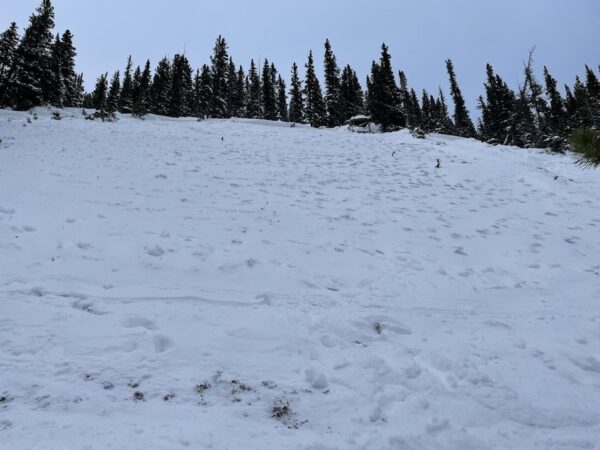Learning from tragedy in Colorado backcountry

On Tuesday, Dec. 27, my wife and I and two of our three sons took an all-day avy prep course with Apex Mountain School in EagleVail. It was a morning of heavy classroom work followed by a field trip up Chalk Creek near Fremont Pass. I highly recommend the course.
Three of our biggest takeaways: (1) there’s no such thing as “sidecountry,” because once you go out a gate at a ski area, it’s uncontrolled backcountry (something we already knew but observed somewhat loosely); (2) the importance of checking the Colorado Avalanche Information Center (CAIC) site and skiing certain slopes (above 30 degrees) according to current snow conditions; and the need to always carry a working transceiver, shovel and probe and know how to use them.
All of these things were back of mind for us over many years of skiing the Minturn Mile to the Saloon out of Vail’s Game Creek Bowl, the Stone Creek Paulie’s Plunge trail to our home in EagleVail out of Beaver Creek’s Rose Bowl, and other what we considered “safe” sidecountry routes that, in fact, exposed us to avalanche danger in the Colorado backcountry. All without proper avy gear, we somewhat ashamedly admit.
We are casual (obviously too much so) backcountry skiers who never go into the East Vail Chutes and are mostly found skinning up low-angle Meadow Mountain near Minturn with our dogs. But we always knew, after acquiring alpine touring gear during the brunt of the COVID-19 lockdown, that we should take even our casual backcountry travel more seriously, especially as the boys expressed increasing interest in skiing more challenging backcountry terrain.
I, especially, know better, and this Christmas (prior to a Bozeman trip where we planned to ski the transceiver-mandatory Schlasman’s Lift at Bridger Bowl), I wanted to get everyone a beacon, shovel and probe and pass on to my boys some of the knowledge I’ve gained over the years heliskiing, snowcat skiing and doing guided trips in places like Silverton and the Ski Utah Interconnect. All of these trips included some level of transceiver training, snow science review and overall instruction on snow safety.
I’ve witnessed avalanches and felt the “whumpf” of snow settling under my skis, including when I triggered a slide onto Highway 50 out of bounds at Monarch Ski Area in college, riding it down onto the asphalt; when I went out the Seibert’s Stash gate at Vail and hiked back out on a day in 2012 when a young skier died on Prima Cornice; and when I asked to be lifted by helicopter off a slope as avalanches were crashing all around us in the Chugach Mountains of Alaska.
But my boys have not had those experiences, and I wanted them to use extreme caution in the backcountry and not be lulled into a false sense of safety in the heavily skied “sidecountry” just outside of those ski area gates. The “You Can Die” signs do not lie.
So after our highly informative, seriously sobering Avalanche Prep Trip with Apex (meant to get you ready for a Level 1 three-day avalanche course) and the purchase of four Ortovox transceivers, we feel far more prepared for both the Ridge Terrain at Bridger and for possibly pushing a little more outside of our comfort zone locally. We learned, thanks to Scott Smith of Apex, how to use vital tech tools such as CalTopo, Avenza Maps, and NOAA forecasting.
And we learned how cavalier we’ve been in the past and why we should look a lot more analytically at a tempting 35-degree slope loaded with untracked snow.
Then four days later, on Dec. 31, we got a heartbreaking reminder of why all of these things matter so much when skiing Colorado’s notoriously unstable snowpack, which is only becoming more unpredictable with worsening climate change. An avalanche on New Year’s Eve, just outside the Breckenridge boundary, claimed the life of a young man in the Numbers area.
In the four days between our avy prep course and that accident, feet of heavy wet snow had settled on an already unstable base layer of snow. On Dec. 31, the CAIC website was lit up with Special Avalanche Advisories that warned: “Large and dangerous avalanches will be easy to trigger … Avoid travel across or below slopes with a slope angle greater than about 30 degrees.”
The initial CAIC accident report did not say what the slope angle was in the Breckenridge avalanche, nor did it state whether the two skiers were properly equipped. One skier had been mostly buried but was able to free himself and skied out to find cell service to call for help. But by the time search and rescue responded, the second skier was found dead.
Last week I reached out to the CAIC and asked about those two things. Slopes in the 35-to-45-degree range are the mostly likely to slide, so staying below 30 is one way to minimize risk. Of course, in deep snow, it’s not as much fun to ski low-angle slopes.
CAIC avalanche forecaster Mike Cooperstein immediately got back to me with confirmation that the out-of-bounds Breckenridge avalanche had been on a 35-plus-degree slope (see picture). As for whether the skiers had been properly equipped with transceivers, shovels and probes, he referred me to Summit County officials for their final report. That information is now on the CAIC website, and, sadly, it turns out the two skiers were not properly equipped.
As I’ve already said, that’s been me on numerous occasions, although typically not on that steep a slope in those kind of avalanche conditions, but I’m not trying to shame anyone in the face of unspeakable tragedy. I’m admitting my own previous errors – the same mistakes too many of us are making in the backcountry – to educate readers about the potentially horrific consequences.
Our Dec. 27 avy course was heavy on safe-travel emphasis, focusing extensively on only exposing one skier at a time so only one person is buried in the event of avalanche and the others can search. I learned this years ago in Alaska, where we would ski 1,000 or more vertical feet one at a time to get to a safe zone. It’s easy to lose sight of that in timbered Colorado terrain.
In addition to asking about slope angle, one of my questions for Cooperstein was the CAIC’s use of the terms “sidecountry skiers” and “sidecountry activity” in the Breckenridge report. Here’s his response:
“The slope angle for this accident was between 35 and 40 degrees. That is correct: if you stick to slopes with a slope angle of less than about 30 degrees, with no steeper, locally connected avalanche terrain above you, you can stay safe from most avalanches,” Cooperstein wrote. “Sidecountry rider is an activity. Sidecountry rider is a distinct user group, like backcountry tourers, snowmobilers, or snowshoers. Those activities all take place in the backcountry.
“Once you cross the rope line, you are in the backcountry. Leaving the ski area boundary is no different from leaving a trailhead. Nobody is performing avalanche mitigation. You should read the avalanche forecast, have all the proper avalanche rescue equipment, and get some training if you are going to be in avalanche terrain.”
There have now been four avalanche deaths in Colorado so far this season, including a father who died on Berthoud Pass skiing with his three sons the day before we took our course on Fremont Pass. That family had transceivers but was all exposed in the same slide area. It’s a place I know well after working in Winter Park and car and shuttle skiing Berthoud Pass.
These tragedies hit home in the close-knit community of skiers across the West even if they’re not literally close to home, as so many backcountry deaths have been in the past. I just hope the growing numbers of backcountry skiers will take the time to learn from these fatal errors and make better decisions of their own before heading out gates and up trailheads.
I know my family has learned some invaluable lessons from both the course we took with Apex and recent tragedies, and I’d urge everyone to read these reports and even take a similar class.
Editor’s note: The Colorado Avalanche Information Center (CAIC) issued the following press release on Tuesday, Jan. 10:
Four people have died in avalanches since December 26 and there is more snow forecast for Colorado this week. “Dangerous avalanche conditions will last through the Martin Luther King Jr. Day weekend,” said Ethan Greene, Director of the Colorado Avalanche Information Center. Early-season snowfall followed by heavy snow in early December and early January created dangerous avalanche conditions. “We have seen more avalanches this year than we do on a typical year, and recently they’ve gotten much bigger,” said Greene. “We want everyone to enjoy the wonderful public lands in Colorado, and go home alive and well to their family and friends on Monday. We need everyone headed into the backcountry to plan their trip carefully and make sure they avoid avalanche hazards. We need to stop this deadly trend.”
Why is this important?
The CAIC recorded over 870 avalanches since December 26. There has been a fatal avalanche accident each of the last three weekends, killing four people. Avalanches are getting larger. People may not see the usual danger signs, but still be in a dangerous area. The avalanche danger is not going down so expect these dangerous conditions throughout the holiday weekend.
What can backcountry users do?
The most important thing you can do is check the avalanche forecast before going into the backcountry. This includes easy-to-access backcountry like right off the highway or leaving any ski area through a backcountry access points. Go to www.colorado.gov/avalanche or get the Friends of CAIC’s mobile app. Look at the current avalanche conditions and plan backcountry travel accordingly. Make sure you and every member of your group carry an avalanche-rescue transceiver, a probe pole, and a shovel – and know how to use this equipment.
Learn avalanche safety basics
A little bit of knowledge can save your life. You can start at the CAIC’s education resources page: https://avalanche.state.co.us/education/resources


Latest posts by David O. Williams (see all)
- During National Small Business Month, Target, DreamSpring put funding bullseye on underrepresented communities in Denver area - May 29, 2025
- Colorado senator urges Supreme Court to hold Trump administration in contempt on deportations - April 19, 2025
- Conductor who brought back Colorado ski train wants to use rail to save state’s highways for skiing - March 20, 2025

You must be logged in to post a comment Login